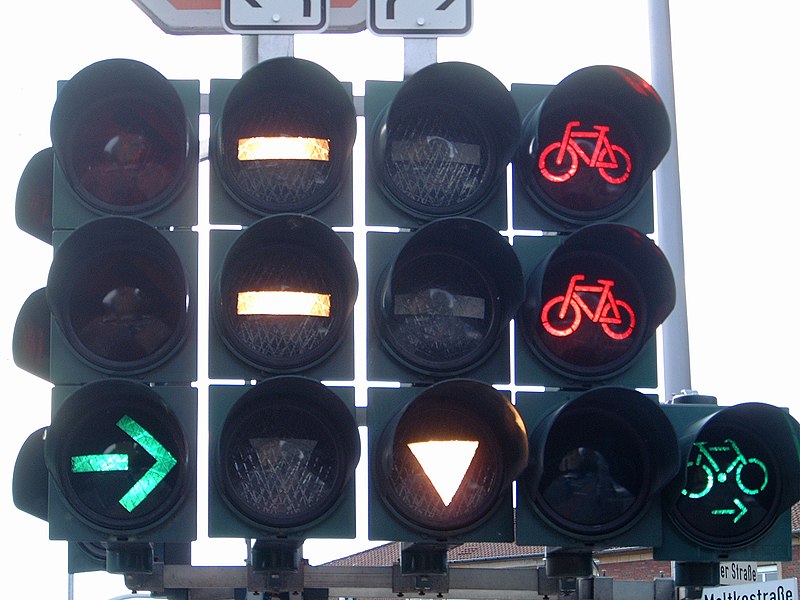Cycling in Hell
Those of you who read CycleDog regularly know that I'm not afraid to rub a cat's fur the wrong way. So it shouldn't be a surprise that I'm not a fan of the Copenhagen style bike lane plans, or their foaming-at-the-mouth, overly ardent admirers. If you want such facilities, move to Copenhagen, but don't make the mistake of believing that similar projects are possible here. There are simply too many differences between our cultures.
First, taxes in Europe are exorbitant by our standards. Sure, they get a lot of public services in return, but if Americans were taxed at similar levels we'd overthrow the government.
Second, fuel costs are staggering. A gallon of gasoline costs roughly the equivalent of eight dollars. Is it any wonder they drive tiny, fuel-efficient cars? Is it any wonder they use bicycles for short trips?
Third, the oldest parts of European cities are laid out on a pedestrian scale. Streets can be narrow, sidewalks almost non-existent, and parking is often some distance away. Some cities have had the dubious benefit of rebuilding their cores after seeing them flattened in two world wars. I don't know of any sane people who'd advocate total destruction as an urban redevelopment option.
Finally, they enjoy extremely high population density, getting to live cheek-by-jowl with the neighbors. "Hey honey! CycleDog is having sauerkraut tonight! Let's get out of here!"
Now, the admirers of the Copenhagen plan would have us believe it's a cycling utopia, and if only we'd build similar facilities here, we'd find our paths strewn with flowers by tall, tastefully dressed Nordic women in stylish footwear.
So imagine my dismay at seeing the following:
In a measure to protect their cyclists, the Danish city of Grenå is funding a large-scale project called “See Mi” that will make navigating the city’s busiest streets easier for both cyclists and drivers. The initiative will see the installation of battery-powered RFIDs in the steering columns of 300 bikes as well as receivers at seven of the city’s most dangerous intersections. The RFID from the resident’s bicycle will send a signal to the traffic light when approaching the intersection; in turn, the traffic signal will automatically flash a ‘cyclist’ sign to warn drivers that they should keep an eye out for cyclists before making a right turn.
(LINK)
RFIDs are usually passive and do not require battery power. But that's a minor point. A much bigger one it this - MOTORISTS DO NOT LOOK FOR CYCLISTS ON THEIR RIGHT, EVEN IN UTOPIA. And a bike lane system merely reinforces this behavior. Cyclists are 'safely' segregated, out of sight and out of mind.
So in order to make this supposedly Utopian system work as it should, another modification, another layer of bureaucracy, another layer of control, and another equally pointless layer of gold leaf has to be applied to Copenhagen's turd of a bike system.
Tell you what - put the cyclist and the driver in the same lane and treat both of them as responsible vehicle operators, and this problem will go away without resorting to another Band-Aid approach. No one questions the underlying assumptions of these segregated bikeways, that cyclists are incapable of learning to ride in traffic, or that it's even possible to ride safely on a city street, because there's too much money and prestige tied up in building more and more facilities. Thunderhead Alliance, Bikes Belong, and a host of advocacy organizations including my favorite, the League of American Bicyclists, turn away from any serious discussion of this.
Labels: Bikes Belong, copenhagen, league of american bicyclists, Thunderhead Alliance




7 Comments:
I'm gonna agree with you, bikes are traffic and should be treated as such.
With that, bike drivers gotta heed all the rules that car drivers do......
I agree with this, too, Ed. Bike lanes can help initially to get more people cycling, and as we all know the number one reason given by non-commuter cyclists who are willing to try it is that it's not safe in traffic. Bike lanes give the impression of safety.
But as I think you've said before, they also give the impression of cyclists "belonging" in bike lanes, instead of simply being a place on the road where cars can't go. This could create an even MORE dangerous situation on the road, when cyclists have to do things like... say... turn left on a four lane road with a bike lane.
I'm more in favor of sharrows as a more realistic plan if a system of road markings is seen as necessary, but I think the ultimate goal is to simply integrate bicycles into regular traffic. And to do that, we're going to need the help of a group that, thus far (in most places I've heard from), has been unwilling to do so: law enforcement.
I maintain that most of our roads are safe enough for bicycles as currently designed, but that lax law enforcement has let people get away with institutionalized speeding, running red lights, "California" stops, etc. The same goes for cyclists, too - when was the last time you ever saw a cyclist get stopped for any of these offenses?
If we could get law enforcement to actually live up to their names and enforce the laws as they are written, things would be safer almost overnight.
Merry Christmas, Ed! :-)
You saw that post in Chainguard, didn't you, where traffic planners in Copenhagen openly acknowledge that "cycle tracks and lanes ... had negative effects on road safety" that are (happily) justified because they "ndoubtedly result in gains in health from increased physical activity", right?
Ah, here's the PDF.
I was aware of that study, Fritz, but I hadn't read it yet. The idea that they uncovered problems but seemed to blithely dismiss them is appalling. It's a given that riding a bicycle has a slightly higher risk than driving a car, but on an individual basis, that risk is offset by the health benefits.
The other thing that annoys me is the refusal to re-examine the underlying assumptions about segregated bikeways. It seems that their proponents always have just another minor improvement that will perfect the system. Just one more step, and another, and another.
If a bicycle were designed using the same process, it would be....a car.
You should look at the charts showing before and after accident and injury stats. While hit from behind dropped moderately (already the lowest rate anyway) and doorings also dropped, some accidents jumped dramatically -- right hooks, for example, jumped nearly 200% if I recall. There was one category that showed something like a 1200% increase.
I don't see how a) acknowledging that right hooks are a problem and b) proposing a solution to the problem can be taken negatively. It seems that, with the increase in ridership, you are going to inherently increase the opportunity for accidents. It only makes sense to try to deal with the issue from both a technological (RFID) standpoint, a design standpoint (Bike Boxes), and an educational standpoint. A full frontal assault, if you will.
Good topic Ed. I agree with most of the points here and would like to pose a question: Isn't anything that increases the number of cyclists a good thing?
The debates are educational, but in Atlanta, we're getting ourselves past many of these debates by simply getting more people on bikes, to more destinations, along more routes. The prevailing attitude is we'll fine tune once we get the numbers up.
Post a Comment
<< Home